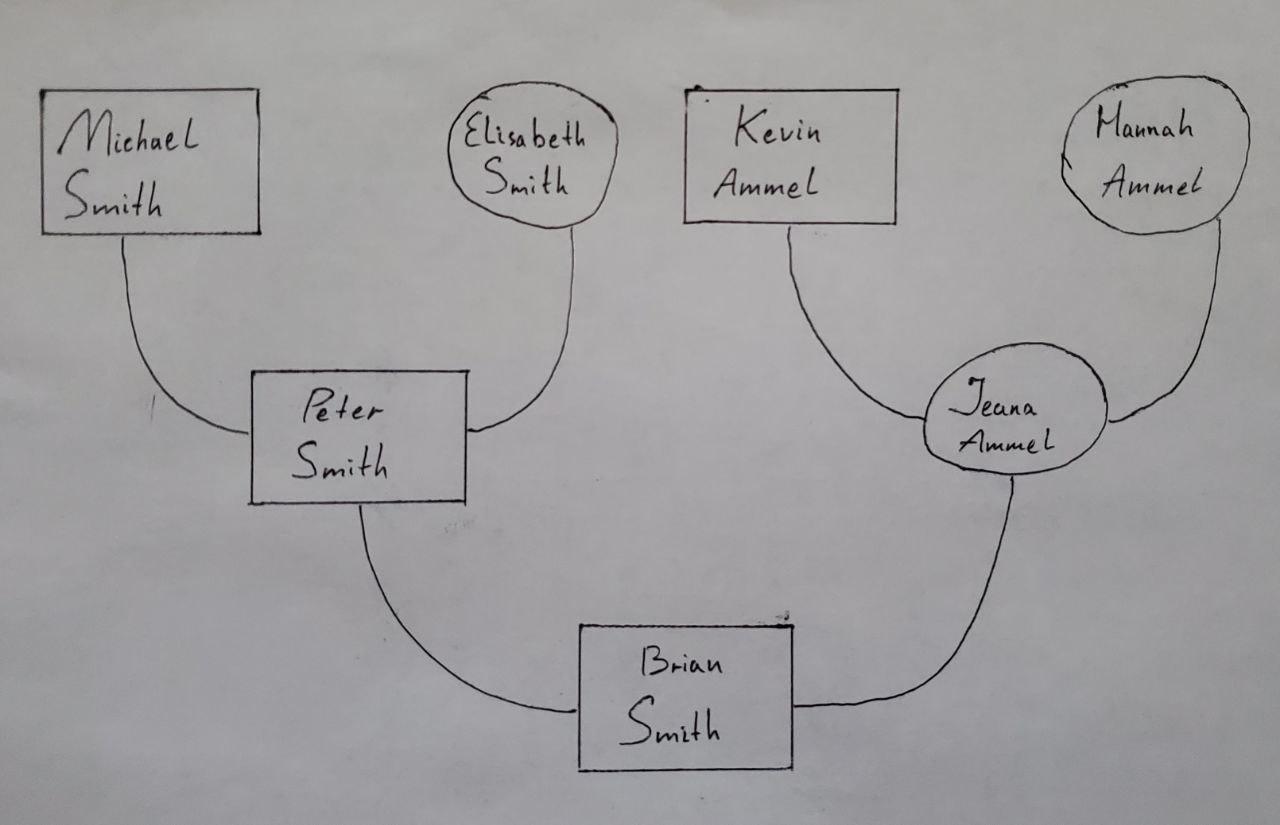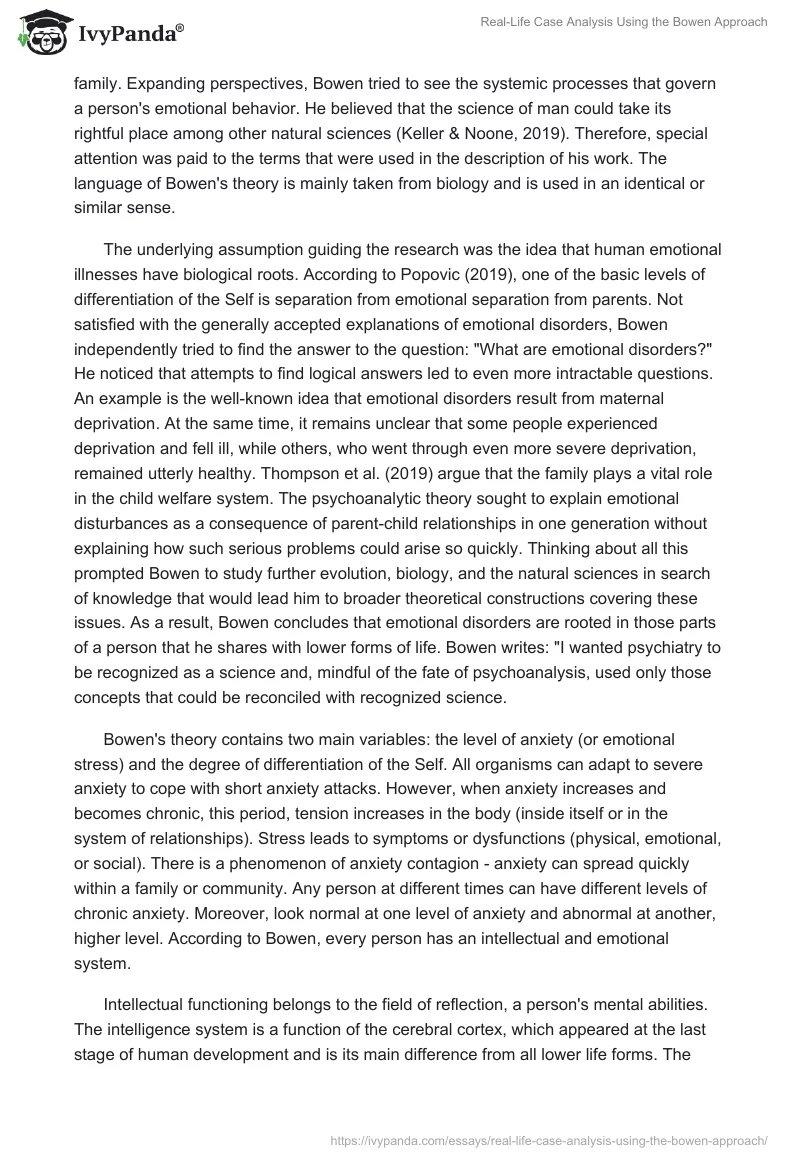Summary
One of the most challenging tasks for a person has always been to observe and study himself. It is relatively easy to be objective about those aspects of nature and the universe that are least involved in human life. It is easier for a man to explain the birth of stars than to understand the nature of human aggressiveness. The ability to judge oneself will always be influenced by subjectivity, causing certain distortions. It is challenging for a person to observe himself, his thoughts, and his behavior without automatically reacting. The subjective nature of the science of human behavior makes it difficult to recognize its place among the natural sciences. However, no matter what, some researchers believe the scientific study of human behavior is possible. Bowen’s Family Systems Theory is the result of just such an approach.
Modern psychotherapeutic thinking is based mainly on psychoanalytic theory, which considers the uniqueness of the mental nature of a person, different from other living forms. Nevertheless, despite his undeniable contribution, psychoanalysis has not achieved full scientific recognition. Being himself a psychoanalyst by training, Bowen posed the question: “why is psychoanalysis not considered a science in the full sense of the word?” In his search, he explored numerous branches of knowledge, trying to find the ideas on which these disciplines were based. As a result, “the idea of man as the result of phylogenetic development from lower forms of life” was born. Bowen’s theory results from an attempt to apply a scientific approach to studying human behavior focused on man’s connection with all living things.
Bowen Model
Bowen Systems Theory and General Systems Theory have similar areas. However, they come from different sources. As noted earlier, General Systems Theory started from understanding the results of the development of mathematics and cybernetics. Bowen Systems Theory is based on factual knowledge from observation of the human family. Expanding perspectives, Bowen tried to see the systemic processes that govern a person’s emotional behavior. He believed that the science of man could take its rightful place among other natural sciences (Keller & Noone, 2019). Therefore, special attention was paid to the terms that were used in the description of his work. The language of Bowen’s theory is mainly taken from biology and is used in an identical or similar sense.
The underlying assumption guiding the research was the idea that human emotional illnesses have biological roots. According to Popovic (2019), one of the basic levels of differentiation of the Self is separation from emotional separation from parents. Not satisfied with the generally accepted explanations of emotional disorders, Bowen independently tried to find the answer to the question: “What are emotional disorders?” He noticed that attempts to find logical answers led to even more intractable questions. An example is the well-known idea that emotional disorders result from maternal deprivation. At the same time, it remains unclear that some people experienced deprivation and fell ill, while others, who went through even more severe deprivation, remained utterly healthy. Thompson et al. (2019) argue that the family plays a vital role in the child welfare system. The psychoanalytic theory sought to explain emotional disturbances as a consequence of parent-child relationships in one generation without explaining how such serious problems could arise so quickly. Thinking about all this prompted Bowen to study further evolution, biology, and the natural sciences in search of knowledge that would lead him to broader theoretical constructions covering these issues. As a result, Bowen concludes that emotional disorders are rooted in those parts of a person that he shares with lower forms of life. Bowen writes: “I wanted psychiatry to be recognized as a science and, mindful of the fate of psychoanalysis, used only those concepts that could be reconciled with recognized science.
Bowen’s theory contains two main variables: the level of anxiety (or emotional stress) and the degree of differentiation of the Self. All organisms can adapt to severe anxiety to cope with short anxiety attacks. However, when anxiety increases and becomes chronic, this period, tension increases in the body (inside itself or in the system of relationships). Stress leads to symptoms or dysfunctions (physical, emotional, or social). There is a phenomenon of anxiety contagion – anxiety can spread quickly within a family or community. Any person at different times can have different levels of chronic anxiety. Moreover, look normal at one level of anxiety and abnormal at another, higher level. According to Bowen, every person has an intellectual and emotional system.
Intellectual functioning belongs to the field of reflection, a person’s mental abilities. The intelligence system is a function of the cerebral cortex, which appeared at the last stage of human development and is its main difference from all lower life forms. The bark allows people to think, reason, reflect, and regulate life in certain areas. A person’s intellectual or cognitive system allows him to observe the functioning and reactions of the emotional system.
Working with families of people with schizophrenia, Bowen noticed that they had difficulty distinguishing between feelings (a more subjective thing) and thoughts (a more objective thing). According to Erdem & Safi (2018), Bowen defined the family as a system through which each member influences the other. They are unable to distinguish between subjective truth and objective fact. Further research on this phenomenon led him to conclude that there is a fusion between feelings and intellect in all kinds of families (from the most disturbed to the most perfectly functioning). The differences will be only in the manner and extent to which they are merged or differentiated from each other. This is the concept of differentiation of I.
People at one end of the continuum do not see the difference between emotions and intelligence. According to Bridge (2019), “Family systems theory demonstrates that differentiation of self is crucial to long-term intimate relationships” (p. 66). Their emotions and intellect are so fused that the life of these people is subject to the emotional system. At the same time, whatever their intellect is, it obeys emotions. They can be excellent mathematicians, but their behavior is entirely controlled by emotions in interpersonal relationships and in their personal lives. These people are less flexible and adaptive, more emotionally dependent on everyone and everything, and quickly fall into dysfunction and recover with difficulty.
Creating a Family Genogram
The genogram is a structured diagram of the system of intra-family relationships in three or four generations. According to Willis et al. (2021), “Bowen theory views families as being intensely, emotionally connected” (p. 2). The genogram uses symbols to illustrate the specifics of intra-family relationships, which, along with other data, are used to depict the relationships of family members and their positions in the family system.

The family consists of grandfather Michael Smith, grandmother Elizabeth Smith, on the father’s side and grandfather Kevin Ammel and grandmother Hannah Ammel on the mother’s side. Father Peter Smith and mother Jeana Ammel (maiden name). All members of the family are white of European race, with relatives on the father’s side coming from England, while the mother’s parents came from Finland. All members of the family profess Catholic Christianity and belong to the middle class. Grandfather Michael Smith was born on May 23, 1939, Grandmother Elizabeth Smith on April 3, 1943. Grandpa Kevin Ammel was born on September 2, 1946, and Grandmother Hanna Ammel on October 8, 1945. Peter Smith was born on January 27, 1977 and Jeana Ammel on November 1, 1981. Their son Brian Smith was born in Vancouver on July 4, 2003. The family has good friendly relations between all relatives. For all the time, none of the presented generations was divorced. At the same time, on the side of the mother of Jeana Ammmel, all relatives have excellent health. However, on the part of Peter Smith, his father Michael Smith has diabetes, but it was not passed on to any of the following generations.
There is little diversity in this family since both sides have long since moved to Canada and assimilated. In terms of Triangulation, there were occasional conflicts in the family between Peter Smith and Jeana Ammel when Brian was old enough. Because of this, they unconsciously involved him in the conflict, which harmed the child’s psyche. Such situations negatively affected his self-differentiation since Brian grew up not independent due to overprotection and excessive restriction of freedom in childhood. These processes are associated with the reactions of the nuclear family since quarrels and conflicts provoke a more excellent removal of the child from his parents. Overprotection also influenced the projective attitude of Peter Smith’s father towards his son. He often imposed those choices that he could not make himself in his youth. Thus, because of this, Brian Smith could not realize his real interests. As for the Multigenerational Transmission Process, they cannot be observed in this family because Peter’s father, Michael Smith, did not impose his interests on his son. Emotional Cutoff was also not present in the family, as none of its members had addictions or problems with the law. Accordingly, despite minor quarrels, the family is emotionally connected. Sibling Position can be traced even though each child was the only family member. However, Peter and Jeanne divided the household and educational responsibilities, and no one violated this framework. The Societal Emotional Process sometimes manifested itself because it could correlate difficult conflict situations in the family with a complex socio-political atmosphere.
As indicated above, the family has a problem imposing foreign interests on Brian Smith. This problem did not allow him to develop normally and grow up mentally, separating himself from his family and differentiating himself. It can be solved by moving away from his parents and starting to live in a separate room, becoming completely independent, or explaining to them that this is not his natural choice and that they influenced him too much. It is also worth learning to separate intellectual and emotional functioning. As soon as anxiety reaches a certain level, the emotional system automatically reacts regardless of the degree of intellectual activity.
References
Bridge, E. N. (2019). Review of a case study in light of Bowen’s theory: Differentiation of self. Yaşam Becerileri Psikoloji Dergisi, 3(5), 65-72.
Erdem, G., & Safi, O. A. (2018). The cultural lens approach to Bowen family systems theory: Contributions of family change theory.Journal of Family Theory & Review, 10(2), 469-483.
Keller, M. N., & Noone, R. J. (Eds.). (2019). Handbook of Bowen Family Systems Theory and research methods: A systems model for family research. Routledge.
Popovic, M. A. J. A. (2019). Bowen family systems theory (pp. 43-69). Springer Publishing Company.
Thompson, H. M., Wojciak, A. S., & Cooley, M. E. (2019). A family-based approach to the child welfare system: integration of Bowen family theory concepts.Journal of Family Social Work, 22(3), 231-252.
Willis, K., Miller, R. B., Yorgason, J., & Dyer, J. (2021). Was Bowen correct? The relationship between differentiation and triangulation. Contemporary Family Therapy, 43(1), 1-11.


